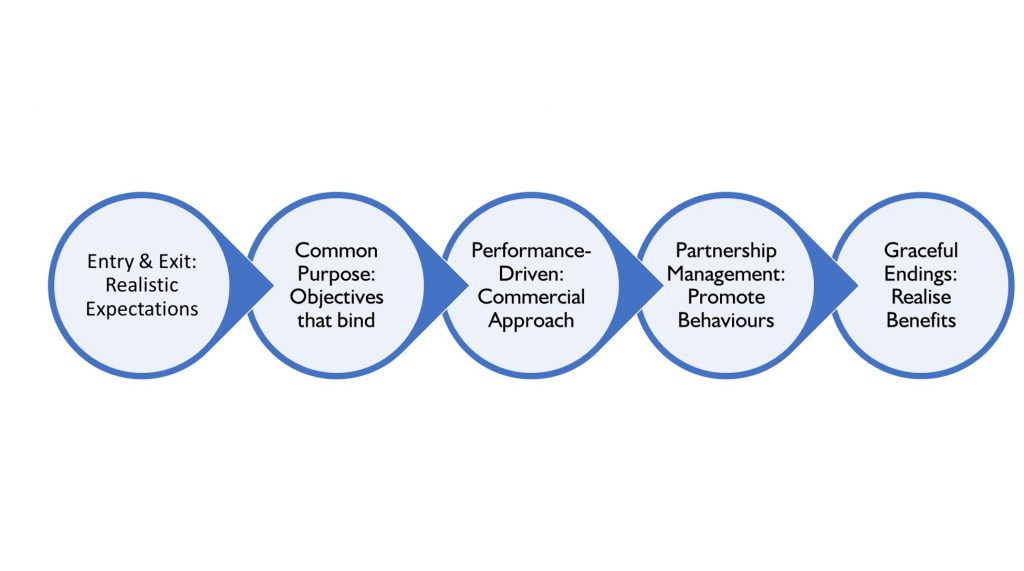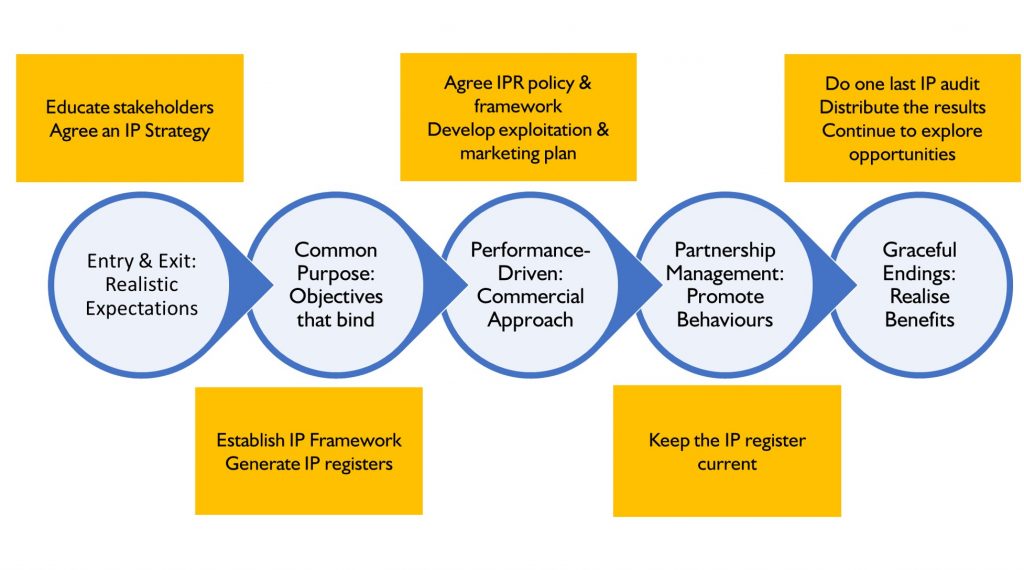
Using Partnership Agreements as a framework to build trust within teams involved in collaborative partnerships
Companies recognise that they can’t and shouldn’t try to be good at everything. Faced with challenges of escalating costs of R&D and investments in NPD companies increasingly look to externalise activities through partnerships, open innovation and collaborative joint ventures seeking benefits of: reducing costs; exploiting external capability and knowledge; access global innovation and markets.
Managing the intellectual assets created in partnership is as important as managing the partnership itself and must align to the business needs of the parties, and their associated IP strategy. To ensure the business interest is protected Partnership Agreements define the activity, and drive good behaviour within the teams if constructed well.
The Partnership Agreements is the anchor to foster trust throughout the venture
Collaborative ventures are typically supported by Shareholder or Partnership Agreements which construct the framework of the activity and establish the rights and obligations of the parties concerned; the expectations for duration, roles and responsibilities; and conflict resolution and exit strategies.
The partnership agreement should be seen as the framework which supports the venture and aligns with the organisation’s IP strategy. Providing a common reference for all parties such agreement allows senior managers to communicate the rights, obligations and expectations to all concerned.
In the absence of clarity, doubt, rumours and hearsay often undermine the trust necessary to build and maintain partnerships. The partnering agreement provides an opportunity to formally communicate issues and demonstrate the parties’ commitments to one another at all stages of the collaboration.

The partnership agreement therefore has two purposes – to set the formal framework for the venture; and to act as a mechanism for communicating the intent to the businesses. This should be supported by a set of pragmatic actions which encourage behaviours and ultimately maximise the value to all parties.
Entry & Exit: Realistic Expectations
Entry is often paved with good intentions and strong desires to increase the value derived from collaboration, but there is often little consideration on how to exit which can lead to future conflict especially where the exit is premature.
At entry
- Understand and communicate what you have. Ensure you have an IP strategy before you sign up to the partnership – understand your organisations approach to IP: ownership and exploitation
- Consider where the value will come from, and in what form. Decide who owns the IP the venture will generate. If the purpose of the venture is to fill technology gaps it is important that all parties understand this goal
- Educate your resources ahead of the partnership. Senior management need to be engaged and buy-in, but developers are key as they generate the IP.
- IP elements of the partnership agreement should include license terms for post-partnership use, and appropriate exploitation and marketing plans. A marketing plan should be developed early on, e.g. to generate joint marketing to promote the outputs.
Plan for exit
- Identify the possible exit scenarios, good and bad
- Build a common understanding of when each party may judge it right to exit
- Establish how the IP is divided, how licenses will be established with scope and life
- Plan for contractual arrangements that need to be dismantled, and how the associate IP may be disentangled
Common purpose: Objectives that bind
There will always be differences between the goals of partners, but to be successful all parties need to recognize the tension between individual objectives and the purpose of the partnership. This can be encapsulated in a partnership agreement and should be communicated clearly to teams.
- Translate individual goals into a common set of mutually supported objectives, endorsed by the senior stakeholders of all parties
- Know what you start with. What IP do you start with – relevant and not relevant to the partnership (you never know what might become relevant).
- Create and maintain an IP register, capturing background, sideground and foreground IP
- Capture what you don’t know. What you need, and what you intend the partnership to generate.
Performance-driven: Commercial Approach
High performing collaborations have carefully designed performance and commercial mechanisms driving behaviours that will drive delivery of the desired outcomes.
The partnership should have a hard-commercial edge and it is important to agree specific outcome-based metrics including for IP. This should not be seen as “not in the spirit of partnering”.
Be clear about:
- Your own expectations for ownership and exploitation
- Identify possible exploitation routes for the foreground IP generated by your organisation during the partnership and be clear to other members
- Duration of any IP sharing – e.g. for the life of the partnership
- Understand what you expect to get out of the partnership. What IP this will require, from your own portfolio and of others.
- Identify what licensing conditions might apply to these and hence the associated risk
Partnership management: Promote behaviours
In order to ensure the maximum value is captured by the initiative, a full and continuous picture of the IP generated must available: an IP register should, as far as possible, reflect the current status of the IP generated by the programme. Capture IP continuously by developers as they create it.
An up to date IP register means you can:
- Demonstrate progress and value-for-money
- Track IP and understand the associated implications and risks
- Celebrate, promote and reward successful IP generation
Graceful endings: Realise benefits
Ultimate delivery is often down to the confidence and trust that develops between the individuals involved.
- Do one last IP audit and get all members to sign it off – agreeing the contribution of all parties and scope of any ownership. This should help avoid any legal arguments later
- Follow through on exploitation plans – for each piece of IP generated identify a route to market
- As a final task, and if the partnership has worked well, try to find new ways of working together.
The process of discussing and agreeing the partnership agreement with key stakeholders in all parties is as important as the end result. It cannot be overstated how valuable such an exercise is in producing a pragmatic and fit or purpose agreement, which can then be used to build trust with the wider teams.
There is a strong relationship between ‘best practice’ partnering and ‘best practice’ IP management in collaborations.

A copy of the original article may be found here: IAM92_IP-strategist_section_0
This article was originally published in IAM Issue 92, published by Globe Business Media Group – IP Division. To view the issue in full, please go to: www.iam-media.com/Magazine/Issue/92.
